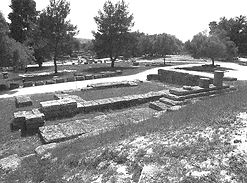
Greek Doric Temples


Olympia Matroon 320 BC
Hitzl , Konrad, "The Roman Iron Age statue amenities Metroon" (Olympic researches 19) Berlin, New York 1991.
Robertson, D.S., Greek and Roman Architecture. Cambridge University Press, London, 1940
Stone III, S.C. "The Imperial Sculptural Group in the Metroon of Olympia" AM 100 (1985: 377-391)
Tomlinson, R.L. JHS 83 (1963: 134)
Winter, F.E., AJA 86 (1982" 395 n43)
Fusch, W. "Dionysos aus dem Metroon Gabel" AN 71 (1956: 66)


The temple of Matroon at Olympia was a small Doric peripteral temple made of limestone, 6 x 11 columns, with cella opening at the eastern end onto a pronaos that was distyle in antis, and a distyle in antis opisthodomos on the west. There was also a colonnade of unknown order along the north and south cella walls. The temple stood on the north side of the Sanctuary of Zeus just to the south of the Treasury Terrace and east of the Temple of Hera. The Metroon served a public function, housing the official archives of the city. The stylobate dimensions were determined to be 10.62 to 20.67 meters; the three-aisled Cella was 6.30 meters long and 5.15 meters wide. The column had a height of 4.63 meters, but that measurement is assumed, although it matches up well with the statistical probability for a structure of this size and configuration.
The Metroon was apparently heavily damaged in antiquity by an earthquake and then restored. During the excavations in the late 19th century, the remains of a Roman Claudius and a Titus statue have been identified, followed by a colossal statue of Augustus.
